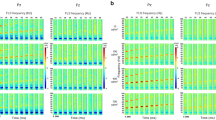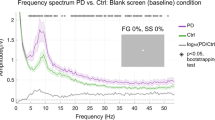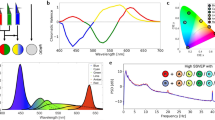Summary
EEG-driving responses to visual stimulation were studied using EEG Interval Spectrum Analysis (EISA) before and after stereotaxic thalamotomy and Nacom® (L-Carbidopa and Levodopa) treatment of 67 Parkinson patients. Five types of photic-driving responses were distinguished in the EISA results: (1) all-band response, (2) Beta-dominant, (3) Alpha-Betadominant, (4) Alpha-Theta-dominant, (5) non-response.
Twenty patients received a daily dose of 750–1000 mg of Nacom orally, and 47 patients 1000–1500 mg for a period of 3 to 4 weeks. In most cases the medication produced no change in photic-driving and EEG patterns. The photic-driving response showed no significant correlation with clinical signs and background EEG.
Unilateral thalamotomy was performed in ten Parkinson patients. In two of these patients the EEG-driving response diminished in the first postoperative week for low frequency stimuli but increased after the second week.
Zusammenfassung
Die EEG-Lichtreaktion auf periodische Lichtblitze von 4–26/s, analysiert mit der EEG-Intervall-Spektrum-Analyse (EISA), wurde vor und nach Behandlung von 67 Parkinson-Patienten untersucht.
Die verschiedenen Muster der Lichtreaktionen wurden in 5 Gruppen eingeteilt: (1) Reaktion auf der gesamten Bandbreite, (2) Beta-dominante Reaktion, (3) Alpha-Beta-dominante Reaktion, (4) Alpha-Theta-dominante Reaktion, (5) keine Reaktion.
Die 67 Parkinson-Patienten erhielten L-carbidopa und Levodopa (Nacom, Sharp & Dohme) in therapeutischer Dosierung. Zwanzig Patienten bekamen eine tägliche Dosis von 750–1500 mg/die, für 3–4 Wochen. Bei der Mehrzahl der Fälle bewirkte die Medikation keine Veränderung der Lichtreaktion und des EEG. Eine signifikante Korrelation von klinischen Zeichen und Hintergrunds-EEG zur Lichtreaktion fand sich nicht.
Bei 10 Patienten wurde eine unilaterale Thalamotomie vorgenommen. Bei zwei dieser Patienten verminderte sich die Lichtreaktion für niederfrequente Reize in der ersten postoperativen Woche, nahm jedoch nach der zweiten Woche wieder zu.
Similar content being viewed by others
References
Baldock, G. R., Walter, W. G.: A new electronic analyzer. Electron. Engng. 18, 339–344 (1946)
Burch, N. R.: Automatic analysis of the electroencephalogram: A review and classification of systems. Electroencephalogr. Clin. Neurophysiol. 11, 827–834 (1959)
Dietsch, G.: Fourier-Analyse von Elektroencephalogrammen des Menschen. Pflügers Arch. 230, 106–112 (1932)
Fukushima, T.: Applikation of EEG-interval-spectrum-Analysis (EISA) to the study of photic driving responses. Arch. Psychiat. Nervenkr. 220, 99–105 (1975)
Green, R. L.: Electroencephalographic Changes in Parkinson's Disease. J. Neurosurg. 24, (Suppl., Part II), 377–381 (1966)
Hughes, J. R.: The EEG in Parkinsonism. J. Neurosurg. 24, (Suppl., Part II), 369–376 (1966)
Kelly, D. H.: Sine waves and flicker fusion. Doc. Ophthalmol. 18, 65 (1964)
Kooi, K. A., Thomas, M. H.: Electronic Analysis of cerebral responses to photic stimulation in patients with brain damage. Electroencephalogr. Clin. Neurophysiol. 10, 417–424 (1958)
Kopin, L. J.: Storage and Metabolism of Catecholamines: the role of monoamine oxidase. Pharmacol. Rev. 16, 179–191 (1964)
Montagu, J. D.: The relationship between the intensity of repetitive photic stimulation and the cerebral response. Electroencephalogr. Clin. Neurophysiol. 23, 152–161 (1967)
Mundy-Castle, A. C.: An analysis of central responses to photic stimulation in normal adults. Electroencephalogr. Clin. Neurophysiol. 5, 1–22 (1953)
Shetty, T.: Photic responses in hyperkinesis of childhood. Science 174, 1356–1357 (1971)
Stenn, P. G., Klaiber, E. L., Vogel, W., Broverman, D. M.: Testosterone effects upon photic stimulation of the EEG and upon mental performances of humans. Percept. Mot. Skills. 34, 371–378
Tönnies, J. F.: Automatische EEG-Intervall-Spektrumanalyse (EISA) zur Langzeitdarstellung der Schlafperiodik und Narkose. Arch. Psychiatr. Nervenkr. 212, 423–445 (1969)
Vogel, W., Broverman, D. M., Klavier, E. K., Kobayashi, Y.: EEG driving responses as a function of monoamine oxidase. Electroencephalogr. Clin. Neurophysiol. 36, 205–207 (1974)
Walter, V. J., Walter, W. T.: The central effects of rhythmic sensory stimulation. Electro-encephalogr. Clin. Neurophysiol. 1, 57–86 (1949)
Author information
Authors and Affiliations
Additional information
Fellow of the Alexander-von-Humboldt-Foundation, M.D., Ph.D., M.S.
Rights and permissions
About this article
Cite this article
Choi, C. Photic EEG-driving responses in thalamotomized and medicated cases of Parkinson's disease. Arch. Psychiat. Nervenkr. 225, 97–105 (1978). https://doi.org/10.1007/BF00343393
Received:
Revised:
Issue Date:
DOI: https://doi.org/10.1007/BF00343393
Key words
- Parkinson's disease
- EEG interval spectrum analysis
- Photic driving response
- Thalamotomy
- L-Dopa-medication




